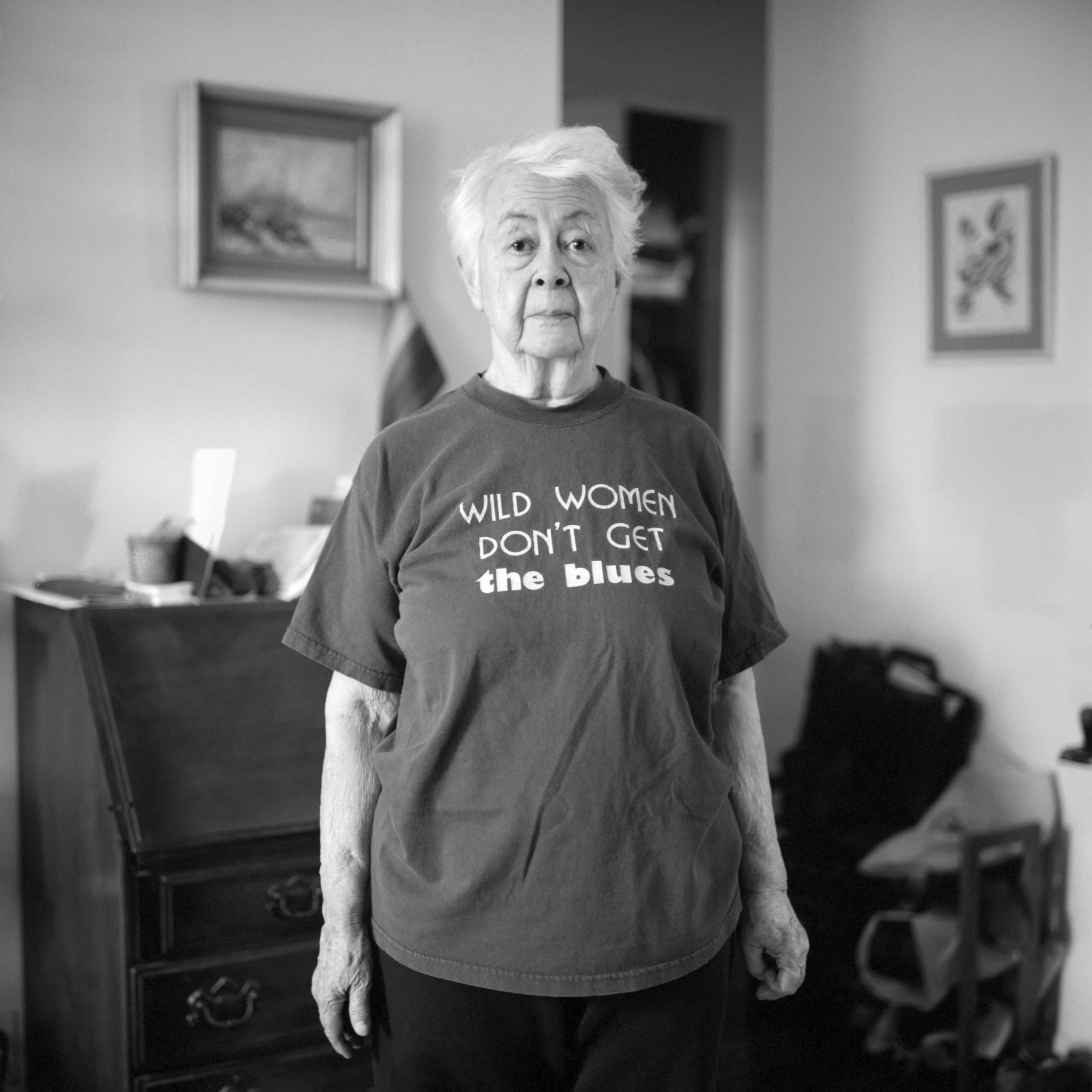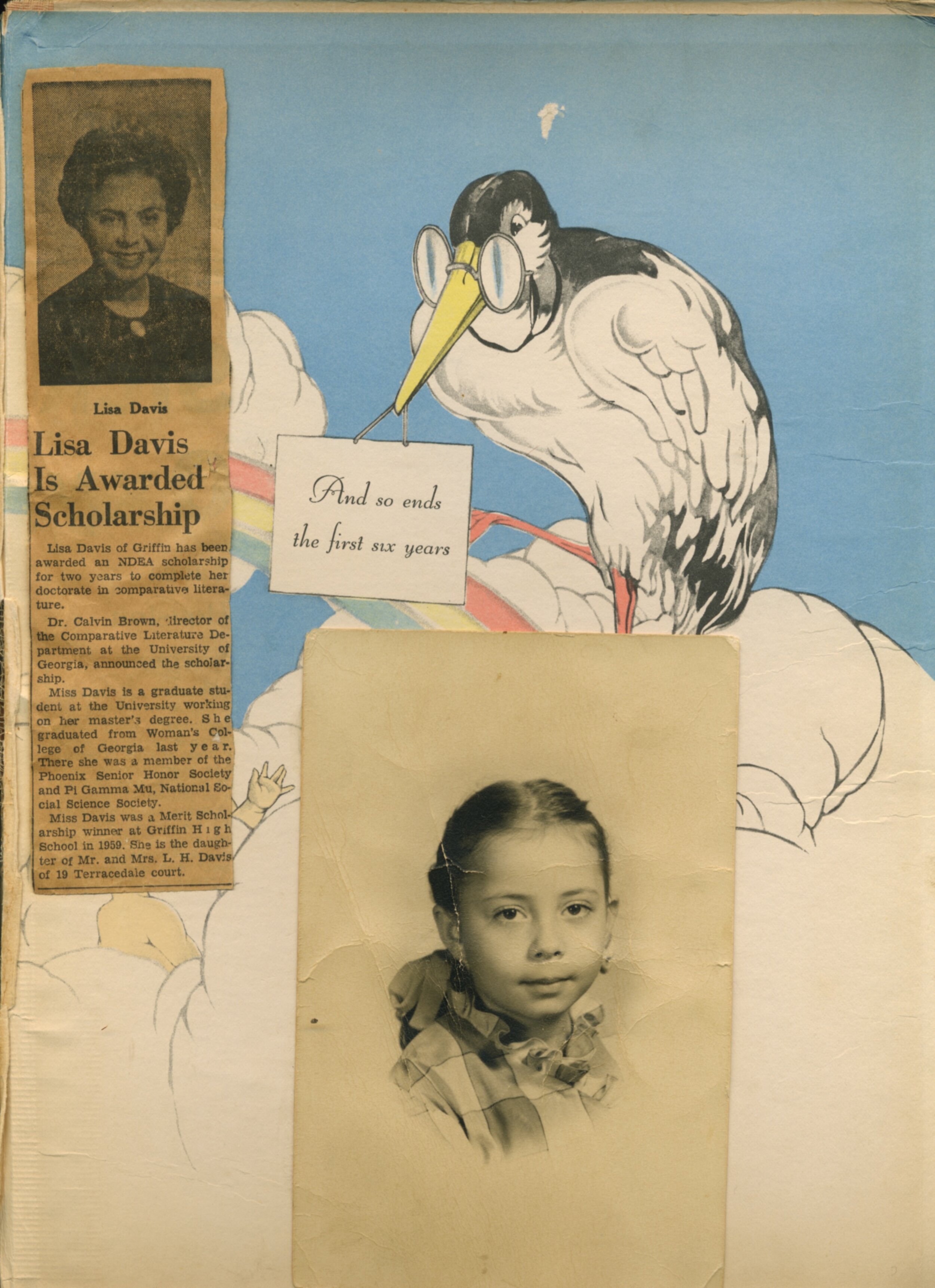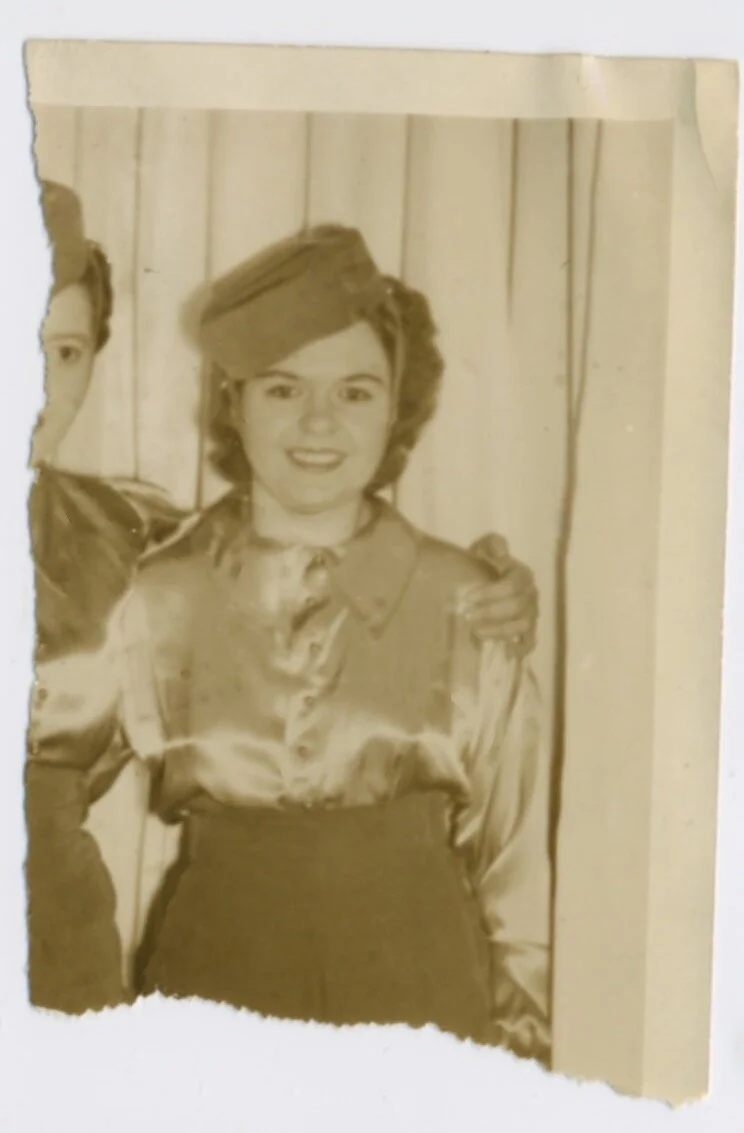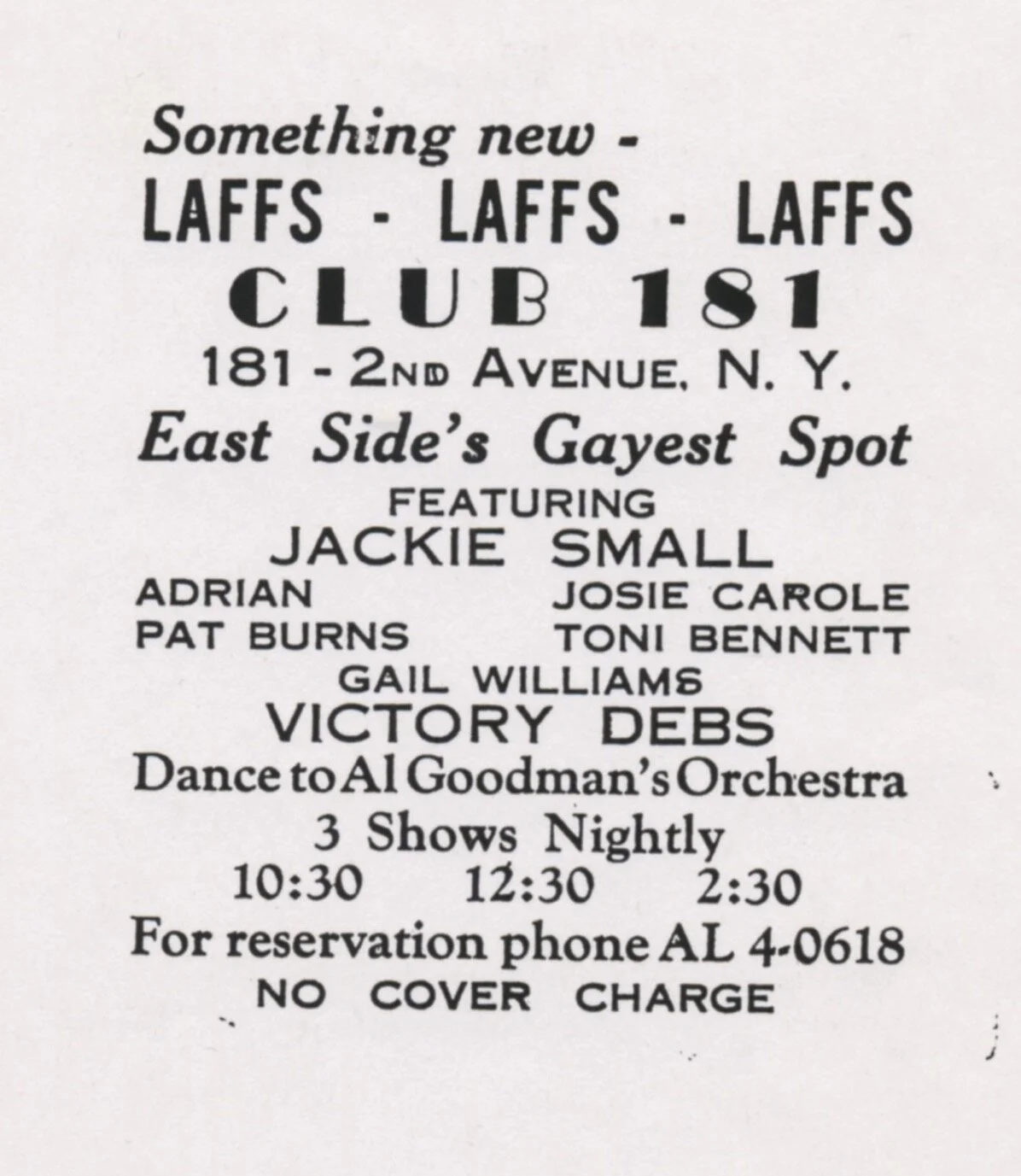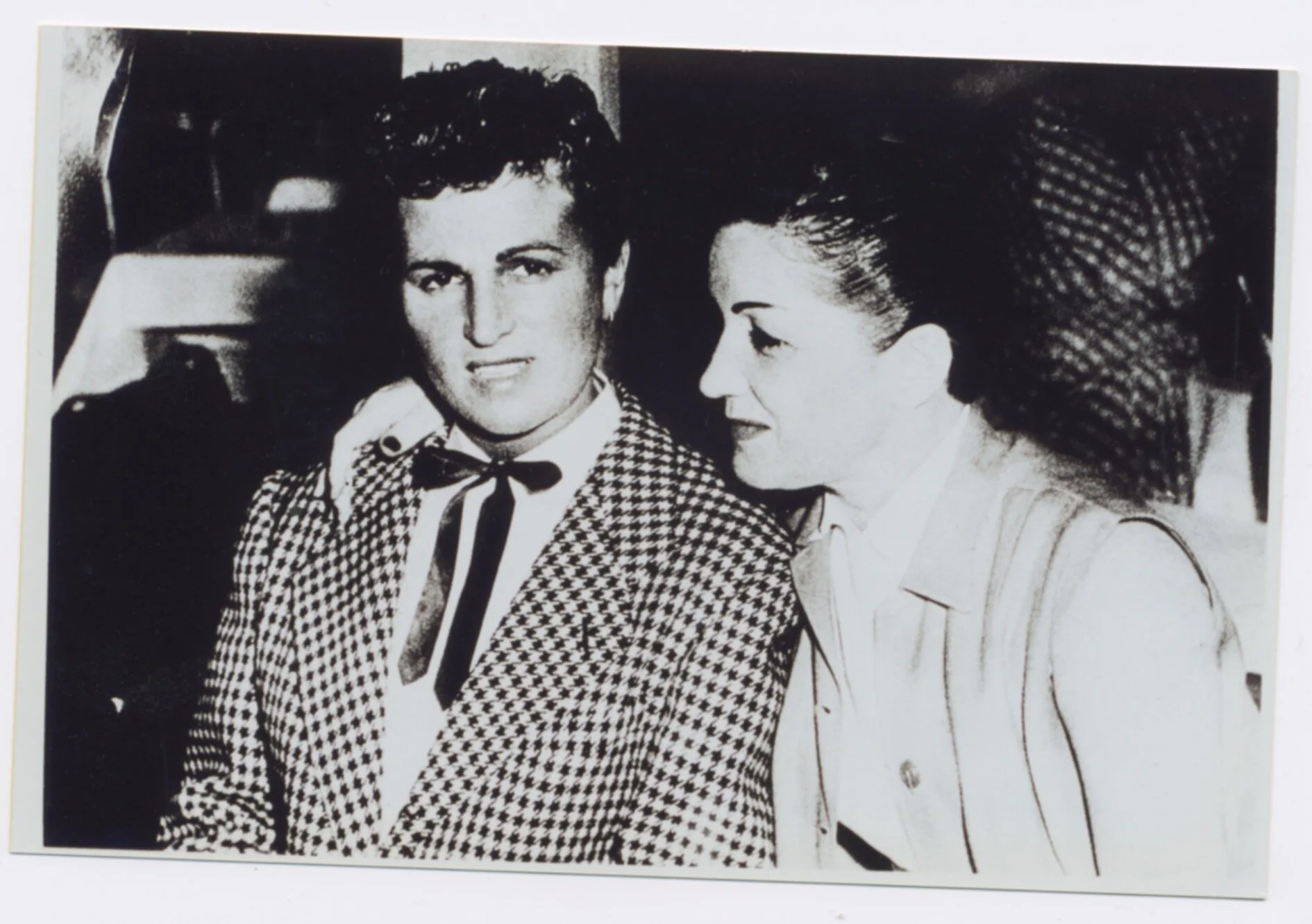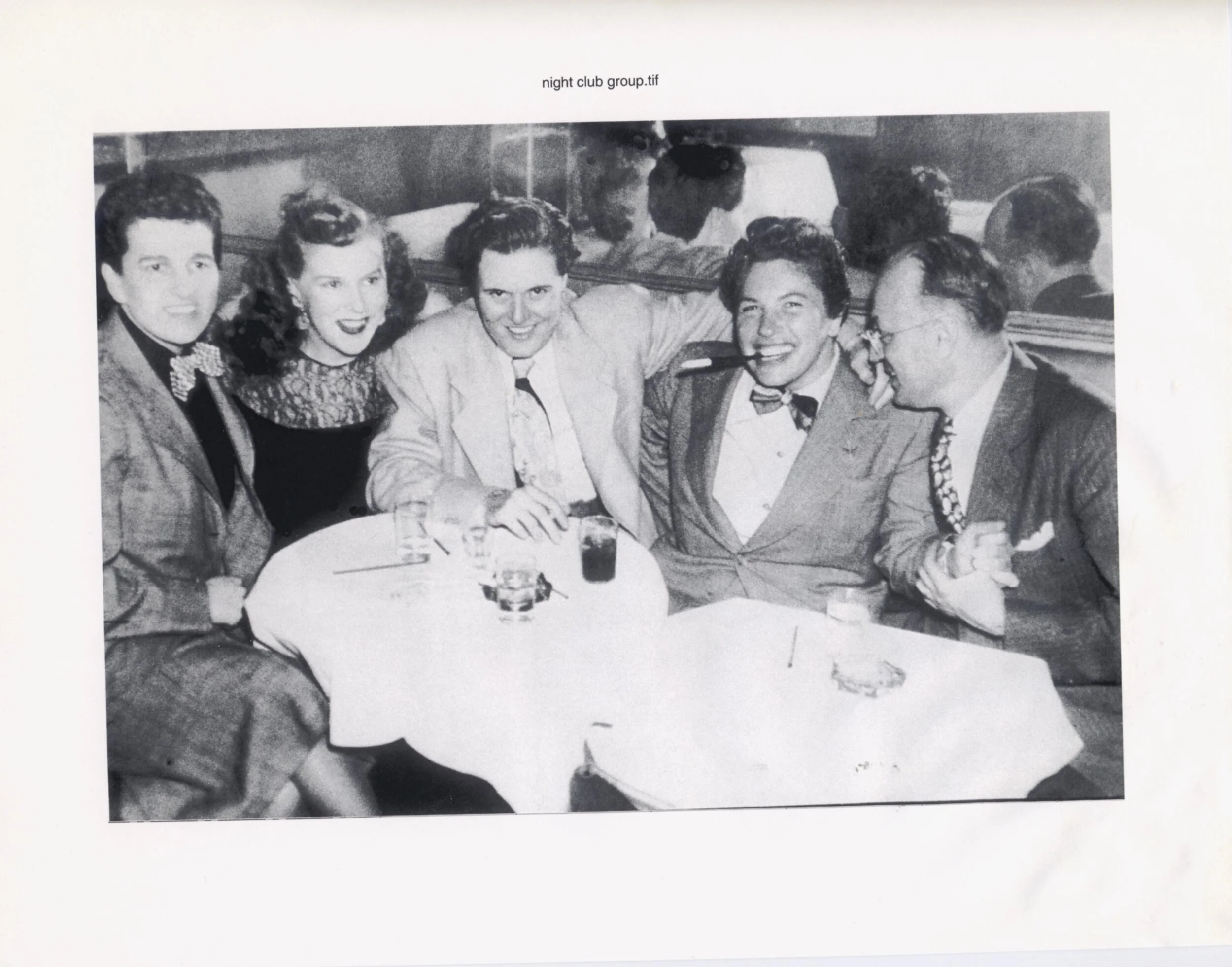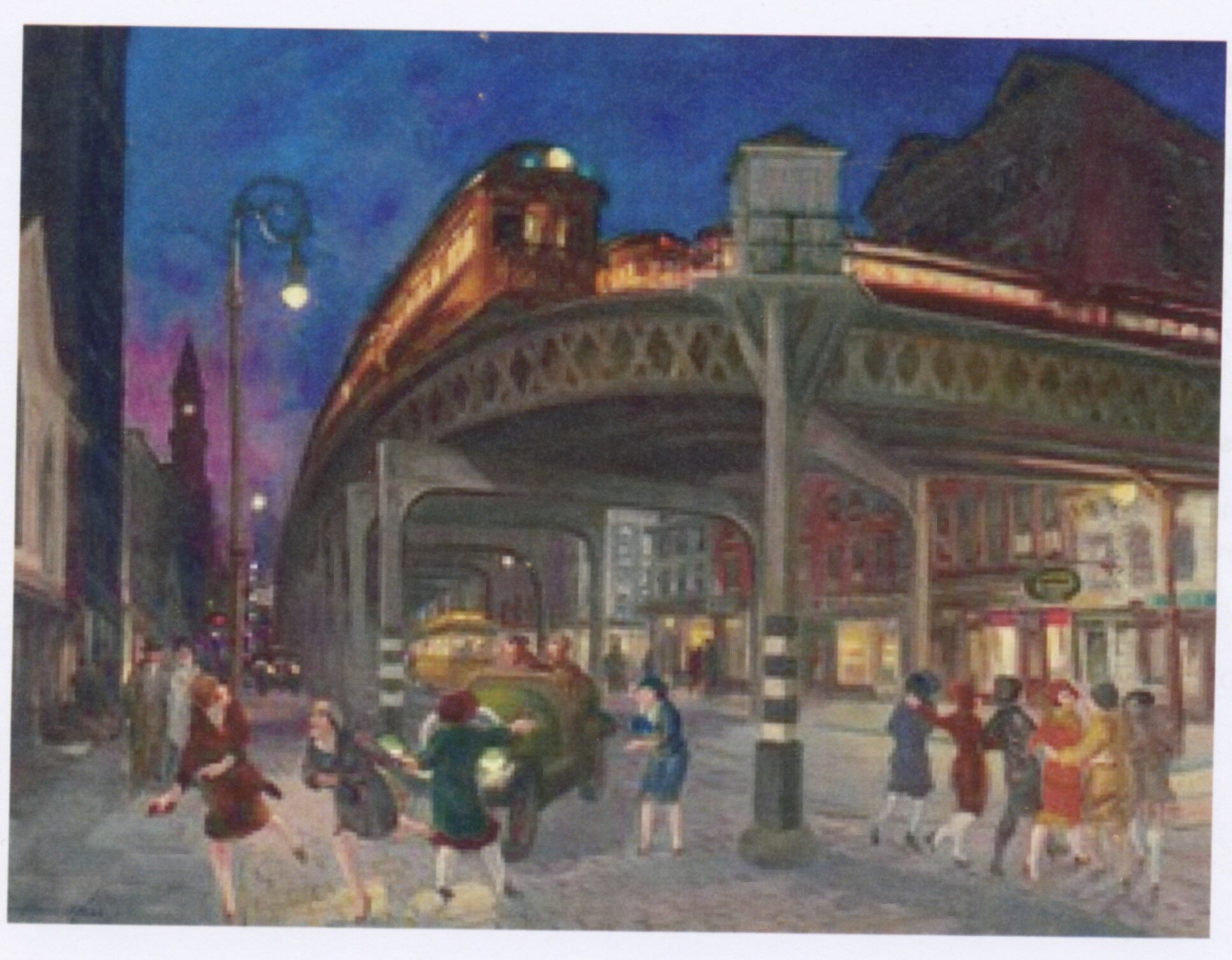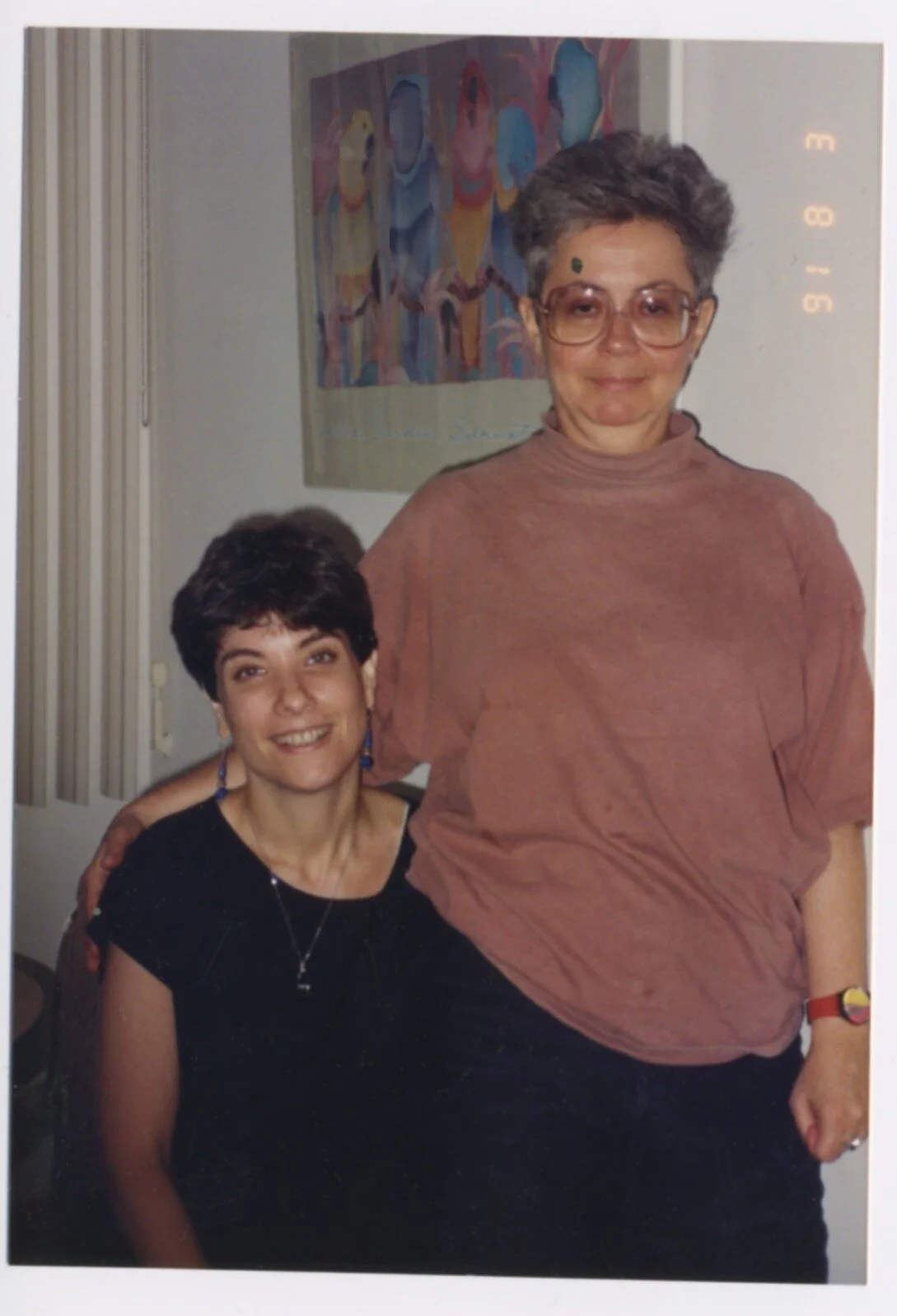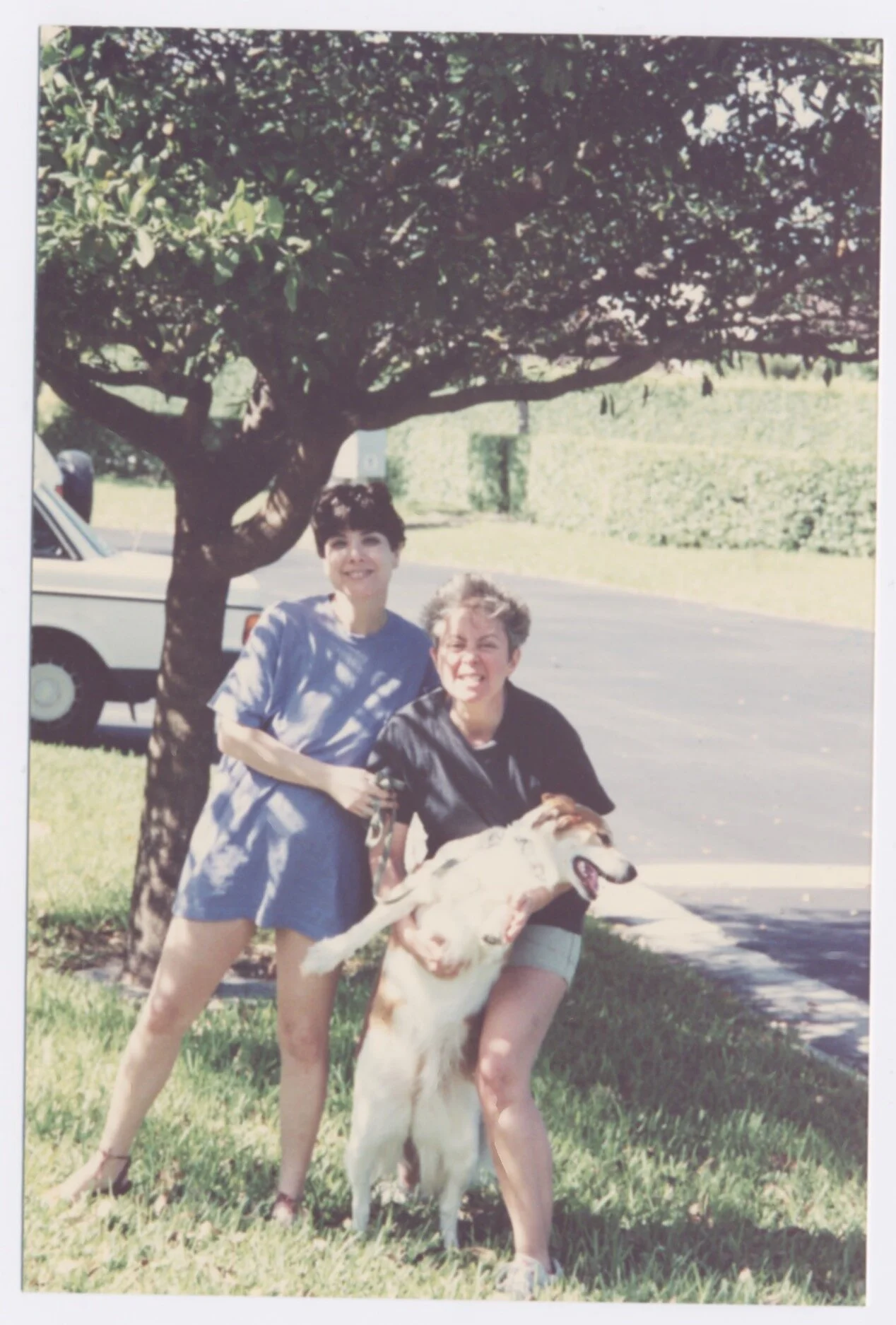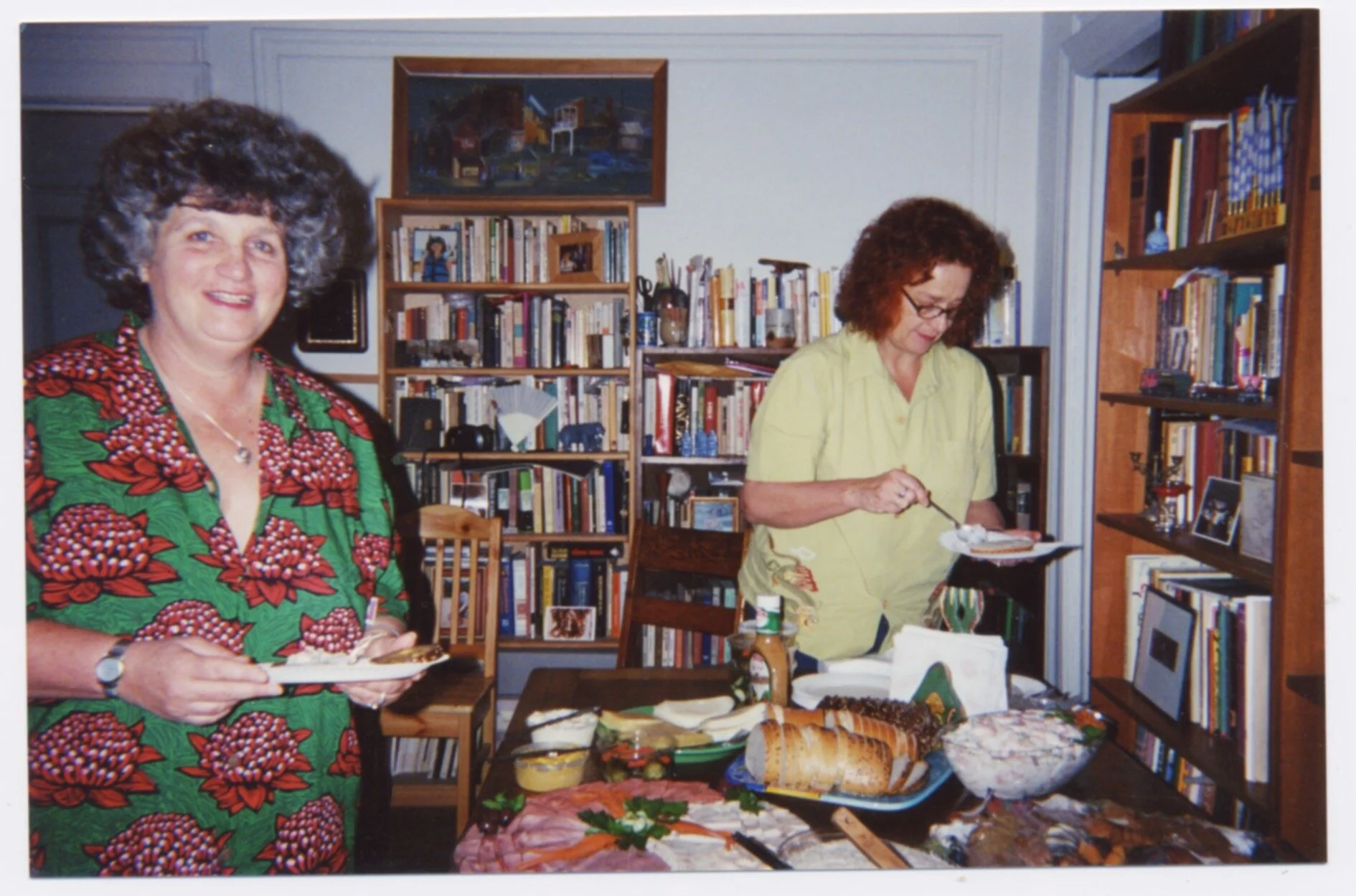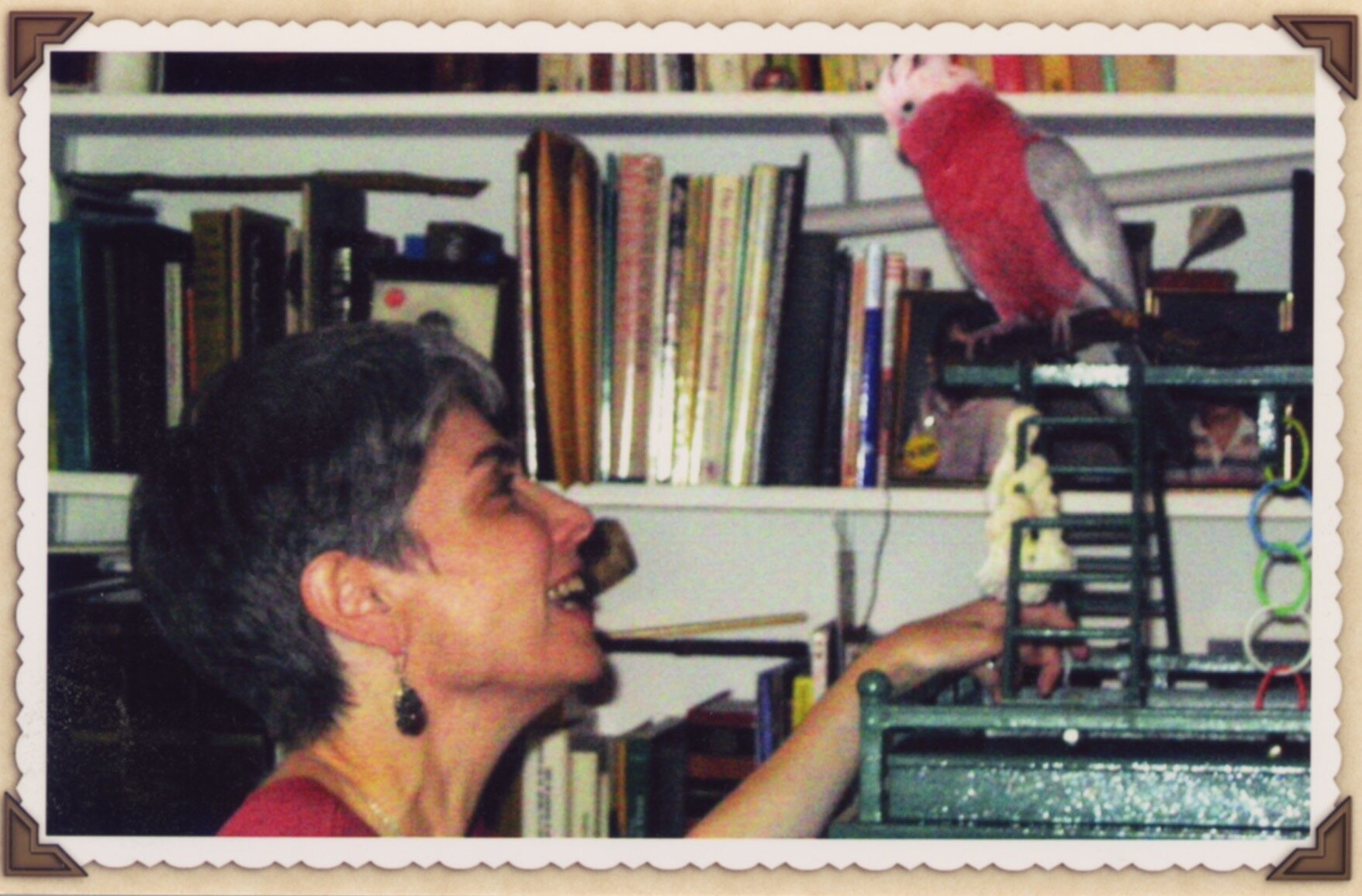Lisa Davis
Lisa Davis is an author, educator, activist and living archive of queer and lesbian history in the Village. Lisa grew up in the South where she studied literature and Spanish before moving to New York City to teach. The following conversation was recorded on February 1, 2020 at 11am in Lisa’s apartment in New York, NY.
Gwen Shockey: Can you tell me a bit about one of the first places you ever were that was predominantly lesbian or queer?
Lisa Davis: Let me just read you the first couple of lines from a story I wrote years ago that was published in one of those wonderful Alyson publications. No one remembers that there was an Alyson Publishing House for years and years until they came to New York and became bankrupt. Nobody knows why. Anyway, a good friend of mine Angela Brown used to be the editor in chief of these anthologies. I wrote a story called “Camp Good News” and it starts this way, “When I turned eighteen Mama sent me to Camp Good News to become a missionary. I became a lesbian instead! Mama wasn’t pleased. She was always trying to turn my life over to God.” Anyway, that’s the way the story starts. If I do say so myself it’s a damn good story. Camp Good News wasn’t actually the name of the camp, we divulge it, but it belonged to the Women’s Missionary Society of the Southern Baptist Convention. As Mable Hampton, Joan Nestle’s buddy at the Lesbian Herstory Archives, once said, “Half the world is queer and to deny it is delusion.” So, I met my first girlfriend at Camp Good News where so many people were lesbians it wasn’t even funny! I mean you could tell! Including the foreign missionaries! I mean who else is going to go off into the bushes somewhere preaching the gospel except some crazy dyke who didn’t want to get married and needed to get away from home! So, I met her and it was wonderful and she was wonderful and I did all sorts of insane things to try to follow her around. She was older than I was. Probably about seven years older! She was on her way to nursing school in New Orleans so we kept in touch with letters. We wrote each other all the time and I saved them very carefully and I did see her of course on a number of occasions and Mama found the letters, read the letters and she felt she needed to call the preacher and the police and anyone who might intervene. Anyhow, it was the end of a lovely affair. That was my first love affair. I never forgot it.
GS: What was her name?
LD: Her name was Peggy.
GS: Have you reconnected at all since those days?
LD: Oh, no darling. I did meet along the way another girlfriend of hers. That was a few years back darling.
GS: So, your mom was not pleased.
LD: Oh no! She was not pleased!
GS: Were the letters pretty sultry?
LD: Well, we spoke of love and things we were doing and how much we loved each other. I wasn’t supposed to love anybody except god I think.
GS: Well, you found some god in her maybe.
LD: That’s right. Well, that’s a whole other story I’ll spare you. A story I’ve been telling the psychotherapist for many years.
GS: Well, that is an incredible story! Where did you grow up?
LD: Well, I grew up in Georgia and I went to college in Macon, Georgia, and there were a lot of lesbians and gay men in the town where my college was. This was in the early 1960s which were good times, really. They were great times. Martin Luther King was marching, which was the bravest thing anybody ever did in this country. He got by with it because it came out of the church and because he got a lot of publicity. Of course they shot him anyway, but in the meantime he had quite an impact. So, there was that and we were beginning to not like our imperial wars, and that was good and that sort of kept us busy!
GS: Did you meet other queer women at school?
LD: Within the university per se not so much except for my Junior Counselor but the people I met were people from the community in the town because--and this might get a bit complicated--but my old history teacher from high school had gone to Macon to do something and he was there. I’ve written about my relationship with him. I loved him. He loved me. We were buddies forever. He looked me up and I looked him up, and he of course knew all these people! So, I got to meet all these people and we were having a nice time until Burge, I think his name was, bumped his wife off and then the heat was on.
GS: This man was in the circle of people you knew?
LD: Yeah! He was sort of in the circle. A rich guy, not among the purged.
GS: What do you mean by purged?
LD: Well, one of the people we knew… Sandy Dent? I think that was his name… Sandy, who was this tall, really gorgeous drag queen type who was married to this nurse who was this dyke involved with this other dyke who was a nurse who were on duty in the hospital where Burge was when his wife was bumped off, which made the plot thicken! Of course Burge was sort of in love with Sandy so that made it even more interesting, and let’s just say that they were under a lot of pressure to hide and to get the hell out and hoping they avoided getting up on that witness stand and going to jail or whatever.
GS: So they were forced out of town basically?
LD: Yeah, they left.
GS: Wow! This sounds like a soap opera! It’s very dramatic!
LD: Well, it was! It’s always like a soap opera!
GS: And you were watching all of this unfold while studying?
LD: Well, they didn’t give you that much to do. (Smiling) This was a lot more fun than what they gave you to study.
GS: Were these people a lot older than you?
LD: Probably not. They just seemed older. Maybe ten, fifteen years older. Maybe a little more or a little less. They were not old. Some of the dykes may have been somewhat older. They were people who followed the softball leagues. Macon, Georgia was also a center of black music at the time for many reasons which I will spare you. But anyway, there were bars where gay people gathered unofficially as there were in Atlanta. That would have been long before Stonewall but that’s because there are gay people all the time everywhere! And they’re always gathering! I was just reading this thing in The Nation – I don’t know how Channing got into The Nation. There is this guy Channing… what the hell is his last name? Well anyway, Channing, who is a journalist out of Southern California but he’s in New York right now because he got some money, because he discovered drag queens who had been in slavery. [The article is called “The First Drag Queen Was a Former Slave” by Channing Gerard Joseph.] There was a whole drag thing and that thing they do from time to time, a whole performance and gathering… a drag ball! There was a drag ball in the 1880s in Washington D.C.!
GS: Wow! How did he discover that?
LD: He was reading old newspapers! That’s what you do! You read old newspapers! He found something about a “negro dive bar raided…”
GS: Were the unofficial gay bars in Georgia ever raided?
LD: Oh, I’m sure they were raided from time to time.
GS: Did you go to those places?
LD: I went to some in Atlanta, some in Macon, some in Savannah which was more fun… Savannah was a great town. Unfortunately it’s been discovered so I’m sure now its unaffordable, but it was a great town before. That was the only place I can recall I ever was in the South that was integrated. Anybody and everybody was there. That was once again when I went to visit my old history teacher who by that time was in Savannah because he left Macon too. And I left Macon and went to another school! It was an exciting freshman year!
GS: So you transferred during your freshman year? Why was that?
LD: Because it was time to get out of town! Burge… Chester Burge had had his wife murdered and the police were going after the gay community.
GS: Oh! So, you felt targeted too?
LD: Definitely! A friend of mine at school, Sally, got caught at one of those bars downtown in Macon. She was a nice, upstanding, Christian, Baptist girl and she got caught in one of the bars in Macon. And they got her student ID and all that, and she was out of the school like that, and out of the town the next day.
GS: Did you get kicked out of the school for being gay?
LD: No, I didn’t get kicked out because I’m not as dumb as Sally. (Chuckles) No. I just left.
GS: That sounds really intense! Were you scared?
LD: I don’t know. (Laughing) I don’t think so! Then I went to the Woman’s College of Georgia where definitely everybody was a lesbian. That was quite pleasant. I had lots of nice girlfriends. I’m still in touch with one of them. She went into the Peace Corps after college and met somebody in the Peace Corps who was later my girlfriend, and then we were all girlfriends... (Laughing) They were in the Peace Corps in Turkey.
GS: What were you studying in college?
LD: Spanish! Spanish, English, literature, whatever arts. But at least the Spanish got me a job at the State University of New York at stoned brook (Stony Brook).
GS: Teaching? Yeah. Right after college?
LD: That’s what I did after a few years of graduate school. I went to graduate school right after college. There was something called the National Defense Education Act. Nobody knows about that anymore. The kids who owe five-hundred-thousand dollars. The Russians put up Sputnik so these people panicked, “Ah! The Russians are taking over!” So, they put up all this money for graduate studies in, I assume, thousands of fields since mine was Comparative Literature, which I think was not particularly threatening to the Russians. I guess when we got to the moon we could sit around and compare literatures. BUT they paid for it. They paid for everything. It cost me zero.
GS: Well, I’m envious of that!
LD: That’s how it should be. They could do it. They [the U.S. Government] can do whatever they want to. Things have changed. Plus the decline of empire. They can no longer run the world.
GS: You had some girlfriends in the second college you went to? Then you went to grad school… did any of those ladies go with you or you moved on? (Laughing)
LD: No, they didn’t go with me. I found some companions along the way.
GS: Remind me where you went to graduate school?
LD: University of Georgia. It was a very good program in Comparative Literature. Except for a professor, who when I asked for help finding a job and getting published, put the make on me. They do that. They do that. I don’t remember what I said, but he never helped me ever again.
GS: That’s horrible.
LD: BUT I got some other help from somebody I knew from the National Defense Education Act through workshops that they had in the Summer for teachers of Spanish. I had worked in those and he worked at Stony Brook and gave me a job! That’s how you get a job, you have to know somebody. Sometimes you have to sleep with someone. I had to sleep with a woman to get my second job. Good thing that was a woman. This was at York college in Jamaica, CUNY. She’d been telling me she was signing me up, signing me up, and I go: So, SIGN me up! Then I went to bed with her and the next day she signed me up! Ah! Love is grand! This probably isn’t a very encouraging chapter in your oral history!
GS: It’s definitely an intriguing chapter in the oral history!
LD: Well, I didn’t know what other people did! What did they do?
GS: I think it’s still often like that! Maybe I’d be more gainfully employed if I did that! Get myself a salary bump! (Laughing)
LD: Is there anybody we know?
GS: Keep an eye out for me, Lisa! (Laughing)
LD: (Laughing)
GS: What was it like to come out or be out when you were younger? Did you come out to your parents?
LD: God, no! My mother? For heaven’s sake! She knew because she had read all of my letters. She knew I wasn’t getting married. She knew that the only guy I ever saw was my old history teacher. (Laughing) What did she call him… “Old squirrel head”.
GS: Was it a thing to come out like it is now when you were young?
LD: I wouldn’t even tell my parents where I was going! I’d say: Hey! I’m going out to the supermarket and I’d drive to Atlanta! No, I wouldn’t tell them. My father said to me once, “We don’t care if you don’t get married! It’s alright!” He was a nice, nice man. My mother was not, but she was tough as hell. Of course she had to be. These were the people who came through the Great Depression.
GS: Where are your parents from?
LD: Well… Thelma came out of the cotton mill and Herschel, that was my father, his family were tenant farmers in North Georgia. They had nothing except lots of children. I don’t know how they survived. Well, I do actually know how they survived, and his name was Franklin Delano Roosevelt and the New Deal. When they talk about the Green New Deal that’s what they’re talking about, and they better be thinking up a new one! That means you split up the money, that means you tax the rich, and you help people. You give them unemployment insurance, you give them social security – and now the pig [Trump] wants to get rid of social security. WOW! That ought to be fun! And Medicare from Lyndon B. Johnson the last of the New Dealers… that would really be something! So, we have to get rid of him!
GS: Yes we do. We sure do. So, it sounds like you were finding a lot of lesbian community along the way, right from the start!
LD: What did they used to call it? Gaydar! You always knew! There were always people! You might not meet one everyday, but you’d meet one every week or two!
GS: You moved to New York for work, yeah?
LD: Yes! Well, I was in love.
GS: Ah! How it always begins!
LD: I was in love. I was in love with this Cuban chick named Rosa. She taught in West Babylon – you know the island of golden dreams? I, of course, wanted to be with her! I met her at one of these National Defense Education Act summer programs.
GS: You find all your love in the summertime, huh? (Laughing)
LD: Well, that’s the only time you have spare time! So, I got this job because of that guy I met at the same time. Thank God for the National Defense Education Act! Thank you for passing that, whoever you were! So, I went to Stony Brook, which was an inconvenient drive across the Island of Long, but that’s alright.
GS: You were living on Long Island?
LD: Of course! But in the end I moved into the city.
GS: And how old were you when you moved to Long Island?
LD: Twenty-something! Four, five, six?
GS: So, it would have been the mid-sixties?
LD: Mhm!
GS: What was going on in New York at that time?
LD: Well, we were busy riding the bus back and forth to Washington to raise hell! We had a few demos in New York, but we went to Washington on the bus to tell them to get the hell out of Vietnam! Whether that helped or not, what really helped was that they lost the war, as you could see from the evacuation of the U.S. Embassy in Saigon so they had to get the fuck out. We spent a lot of time doing that.
GS: You were involved in a lot of political action and activism?
LD: Everybody was. It was disgraceful. The only people who were going were drafted! They still had a draft. Now, they got rid of the draft after Vietnam because they understood that it caused them more trouble than it was worth. So, yeah! That’s what we did for a while!
GS: And you were living with Rosa?
LD: Ah! Rosa! I was dating Rosa and we were living together in Babylon – no, Brentwood! In the Brentwood! She rented whatever it was… domicile… and that was the only place that would rent to someone with a Latin name! Because Brentwood had already been “destroyed” by having all of these Hispanic people living there. I think it was totally Hispanic. They had gangs and things. Long Island was a trip honey! What a crazy-ass place!
GS: Did you feel safe living with another woman there?
LD: People were just busy doing whatever people do! Washing the clothes, washing the floors, washing the children! Nobody bothered us. Of course, we were teachers, and teachers were always ok.
GS: You were teaching Spanish?
LD: Yeah. Spanish whatever…
GS: Ok. And were you involved in any of the early Gay Rights activism then?
LD: Oh, that would have been fun, but I wasn’t there! I’m more involved now because I know all the people. Jim Fouratt is a very good friend of mine. People were not nice to Jim. When all of these out-of- towners came last year and took over at Stonewall… All the pictures ever taken of the Liberation Front, Jim is the front row! They’re not! They’re back in Portland and Oahu or wherever the hell they came from. For them it was just an exciting time. For Jim it was life.
GS: So you were mostly involved in Vietnam-related protests.
LD: Yes, that’s when I discovered that my country was shit. Something I had suspected, but when you’re a kid there’s not much you can do. So, at least we did that. Of course once I moved into the Village it was different. I moved into the Village because the woman I slept with to get the job at York college lived at 15 Charles which is the nice building right across the street from here! That’s the building I should have moved into but at that time it was probably three-hundred dollars or maybe a little bit more. I found this place because I saw a sign hanging outside that said “apartment for rent.” That’s how they used to advertise for vacant apartments. So, you know, I knocked on the door and a nice man said, “Oh hi!” And the rent was the same as another place I’d seen but it had no elevator, no nothin’. I thought: Oh wow! It’s got an elevator! You know how much it was? Three and a quarter. And that was the normal rent! That was 1974, but it’s not 1874 or 1774.
GS: Was this the first Manhattan apartment you moved into?
LD: Oh, God no, I lived on East 74th Street. That was kind of fun. That was a fifth-floor walk-up. I wouldn’t do that again. Where else did I live? Somewhere else! You could move then! You moved around! Took your forty boxes of books… And they’re still here! What are they still doing here? I get rid of some from time-to-time, but it doesn’t seem to make a difference!
GS: Were you going to lesbian bars when you moved to the Village?
LD: (Chuckles) Let’s see… lesbian bars. There was one on East 74th Street… When I was finally in the Village we would go to the Duchess. The Duchess was very nice because it was just around the corner here. We would go to Henrietta Hudson, we would go to the Cubbyhole, which is still up here on West 4th Street. Except it seems to have changed somewhat in its tenor. I think they let straight people in which is a mistake. We went to The Center! The Center was very new back then. They only got it because people sort of chained themselves to the doors. Otherwise they would have taken that and converted it into a brothel or something. Who knows. Anything to make money. That was Ed Koch. Another crook. Those were good times. Those were very good times. I never went any place uptown. I know there were places. I mean, I know that now but I didn’t know that then. I was busy driving the car once again from 74th Street to Stony Brook because I moved off the Island the last couple of years. That takes up a lot of your time. But I’m sure there were places up there. I know there were.
GS: Was it easy to meet people in the Village?
LD: Well, being as I was drinking then… I was usually drunk so if I met somebody I wouldn’t have recognized them the next day anyway.
GS: What was it like in the Village in the ‘70s?
LD: Cheaper. There were some nice little places that don’t seem to be there anymore. But then again there were places recently like the Gourmet Garage around the corner that’s not here anymore either! When Bloomberg was Mayor – “Blumbito” as the Hispanics would call him every time he would start one of his raves in Spanish… “Ay Blumbito…” – as he said when he closed down St. Vincent’s Hospital with his friend who was the CEO of North Shore Long Island Jewish so they could do Lenox Hill up there, “Ah, things change, and we have to move on.” Oh, fuck you. Things change. Please. Of course, it was fun to go to Joan Nestle’s house which was definitely not in the Village
GS: How did you meet Joan?
LD: Maybe I was drunk! I don’t know. (Chuckles)
GS: Did the lesbian community feel kind of close-knit then? Did everyone kind of know each other?
LD: Well, the Lesbian Herstory Archives were very important because Joan Nestle and Deborah Edel, and forgive me if I emphasize Joan, but Joan was a creator of community! That’s what she did along with some other people, and she made people really feel like they belonged to something.
GS: The archives started in her house right?
LD: That’s right. It was an apartment that her mother had. Once again, an old Upper West Side apartment. I can’t imagine what the original rent would have been but probably nothing, and she was either rent stabilized or rent controlled, but they tortured her until she left for Australia! But in any case you just sort of met folks and I think in a way these funny little devices you have now help! It would probably be better if we had our community cell meeting every week somewhere! We might need to work up to that! That means all the people come together and sit and whatever, but social media is pretty amazing because I can write Joan Nestle a note in Melbourne and she gets it! She can’t come to the commie cell meeting, but she gets the message!
GS: Did you ever host cell meetings Lisa? (Laughing)
LD: No. I wish! You don’t want to hear about the history of the Communist Party but they own a building over on West 23rd Street. Wix is in that building and rent from them. But they got that building from some rich old millionaire whose name, of course, escapes me at the moment in the ‘50s or the ‘40s.
GS: Were you doing a lot of writing in the ‘70s?
LD: All the time!
GS: What were you writing about then?
LD: What was I writing about? Well, for twenty or twenty-five years I wrote little things in Spanish and published them but when you teach you can’t write a book unless you get free time and money to write it. The only time I had a sabbatical my girlfriend at the time, another Cuban, moved in her son and daughter- in-law and dog so that was my sabbatical.
Phone rings
GS: Do you want to get the phone?
LD: Well, that’s probably my girlfriend. It’s either my girlfriend or your girlfriend.
GS: (Laughing)
LD: It’s mine!
GS: Sorry we’ve invaded your home, Lisa!
LD: No! I don’t think I’m being very helpful because I wasn’t involved in anything very interesting I guess!
GS: These are exactly the stories I want to be hearing! Your life is incredibly interesting!
LD: Here is a picture of Gail Williams. I got these from her when she was busy throwing them out. Here she is probably at the 181 Club, and you can see the mafioso obviously sitting behind her. She was in entertainment. This is Buddy Bubbles on the far end there when they were running a club on the corner here called the Page Three which was a nightclub.
GS: Was Page Three a drag venue?
LD: It was a nightclub. Straight people and Wall Street people and all kinds of people went. It was not a gay club. These people ran it – Buddy Bubbles and her girlfriend.
GS: How did you find out about all of this?
LD: They told me! I knew Buddy! Buddy gave some pictures to the Archives and she talked to Joan because she didn’t want everything to be lost. She gave some pictures and identified the people.
GS: Buddy’s girlfriend has an amazing smile.
LD: Well, she worked in Paris in the gay clubs in the ‘30s and ‘40s. Shit. I can’t remember her name. You will learn, young people, as you get older it’s the names that go first. Oh, yes! How could I forget? Jacquie Howe. Everybody in the Village back then knew Jacquie Howe.
GS: The Page Three would have been mafia-backed?
LD: Oh, yeah! Sure! They had a connection! Otherwise you weren’t in business! But it didn’t matter. They did all they wanted with little money. Everybody went there. It was not a drag show, it was just performers… whoever! They might be gay, straight, others… There were drag revues that played around the country in small towns, you know, White Plains or somewhere in the local theater they would have a drag show! Buddy and Jacquie lived over on 8th Street in a nice apartment building that is probably totally unaffordable now.
GS: Do you know what years the Page Three would have been open?
LD: Sure! Like, 1953 to ’63. That much I remember.
GS: You never went there right?
LD: No.
GS: That’s a long time to be open! A decade?
LD: That’s right! Gail said TV put them out of business. The dance clubs put them out of business, too. Like the thing Jim Fouratt ran, Danceteria. (Laughing) Put them outta business.
GS: Was Buddy Bubbles involved in other venues or just Page Three?
LD: As far as I know that was the only place she had an investment in because that was the only thing she had money for. She didn’t have any money.
GS: So, Club 181 was owned by Anna Genovese correct?
LD: Yeah, yeah. She ran it more or less. Her brother ran it.
GS: And she was rumored to be a lesbian?
LD: Oh yeah! Well, that’s what the girls would say. They’d say if Anna ever came around you’d try to get out of her way because you definitely didn’t want Anna to try to put the make on you. That was probably not a good plan.
GS: How did you know Gail Williams?
LD: Well, that’s another wonderful story worth recording maybe. Maybe not… She was in show biz! She was so excited. Back to the National Defense Education Act... one of our students was a nun and Rosa, my beloved West Babylon connection, and I were on the faculty. We were good friends with the nun and she said, “When you get back to New York you have to meet my sister!” So, we said: Ok, sure! Her sister was someone named Eileen. I have a picture of Eileen. She was wonderful. Very bright. Everyone was in the military of course. Eileen was Gail William’s girlfriend! So, all this is thanks to the nun! The nun knew that we had to meet her sister because… unbelievable. So, that was Gail. She was an only child. Her father died from the Spanish flu after World War One and her mama had nothing and ran sort of a boarding house. Who knows. She rented out rooms. Anyhow, the girls found their way to the Village in the late ‘30s if not before. Well, before that even the suffragettes had found their way to the Village and most of them were a little queer so it was set up for women. The Village belonged to the girls. The boys weren’t here. The boys were uptown and in Central Park and who knows where! We don’t care where they were. So, Gail went to all these places and somebody told me that when you went to these places if somebody thought you looked interesting they would ask you if you wanted to work at... like the Howdy Club for instance. So, she did. As Buddy Bubbles Kent said, “The mafia was very good to the gay girls.” Gail was, as her girlfriend Eileen said, “A glorified waitress.” (Laughing) That was Eileen. Anyway, she got to appear in her little boy’s outfit and they would probably do the opening number depending on what it was and then they would wait the tables, sell the drinks, sit with the customers – the customers were eager to sit with these people who looked so strange and exotic if you were coming from Jersey or somewhere, and have their photograph taken by the professional photographers. If you could find those people… whatever happened to their treasure-trove of nightclub photography! That’s what they did! They wanted their picture taken with some dyke or some drag-queen. The men wanted their pictures taken with the drag-queens and the women with the dykes. Then they would probably do the closing number. The finale.
GS: When did you start getting interested in this whole history? Dating back to the ‘30s?
LD: Well, I was always interested in history. History was what I did. If you can even call it history. I see it as it happened five minutes ago. History to me is the Peloponnesian war or the fall of Rome or something. But I can’t live without writing.
GS: I want to hear more about your writing and research! Have you heard most of these stories from the people who lived them over the years?
LD: Well, returning to Gail and Eileen they had been out of the business for twenty years or so but anytime they would get together with their friends who they had had for fifty years the first thing they would do was to take out a photo album – now lost. It’s like with Blackie Dennis! I can’t get the photographs! Her cousin will not give up her archive. The Italians are funny. These are the Lombrinos. When Joan Nestle went to interview Buddy Kent she didn’t know anything about this world because this world had disappeared! The history was not recorded. She didn’t know anything. She knew it was history! Buddy was very active in SAGE so Joan thought they were going to talk about SAGE and probably thought she would hear how Buddy had suffered as a gay person. But as it turned out she didn’t suffer at all! She had a great time! She was in the Village!
GS: I feel like there’s so much mystique around the idea of the Village, and you’ve been here at the center of it all over so many decades!
LD: What I’ve seen… What I’ve seen is the rents go up. As I tell everybody, in our building we used to have interesting people: hookers, drug dealers. And now everybody works on Wall Street. The two young people next door right now who replaced the French people are lovely and fun and she works for Google and he tells me he sells things on the internet! Anyway, the hookers and the drug dealers were more fun but they couldn’t pay the rents. But the sidewalks speak to you. The old cobblestones down by the river, they have stories to tell. I just found this thing… do you want me to tell you my latest story? She’s not a lesbian… There was a very famous movie called “Laura” based on a book by Vera Caspary and they changed it a little bit as they usually do, but she wrote all her life! That’s what she did! She was originally a commie in the ‘30s and then sort of drifted away, but she was always a big leftie--a person concerned for other people. My friend Frank at the library has these people come in and do courses, and he had a woman come down from Hunter who taught a course in film novel noir and this was one of the books. So, in the essay at the end she talks about how when Vera was back in New York when she was older she was very concerned for the Women’s House of Detention. She was all ready to write a book about the Women’s House of Detention! I don’t know what happened! Maybe she died. I got the notes from the University of Wisconsin! It only cost me a couple of bucks.
GS: Wow! She had done a lot of the preliminary work for it?
LD: Yeah. She taught a writing group there at the Women’s House of Detention! The only person that I know who was locked up there who we all know well was Jay Toole. Well, Jay has one of the great romance stories ever! You ought to get Jay’s oral history! She’d be happy to talk to you! Right now she’s in Florida because as I said social media has its virtues despite being run by Zuckerberg. And this woman who had known her in, I don’t know, the 1960s was in love with her when she was much younger and ran under some funny name like “Butch” or “Baby” or something, anyway she found her on Facebook! She wrote her and said, “Jay? Is that you?” And Jay said, “Linda! It’s me!” Linda came up here and they renewed their love affair, and Jay has basically been in Florida now for months which is not a bad deal being as she had been with this photographer person who did Jay bad. So, she was having a really hard time but now she’s in Florida with this woman’s family! She’s having just a great time but she’s coming back probably in March with Linda. This story should be written down and published somewhere. Zuckerberg should finance it! It’s a social media success story! They found each other! It probably saved Jay’s life! Jay was doing her walking tours and making a couple bucks but she didn’t have anything!
GS: I think a lot about the people who have stuck around in the Village over all these years like yourself and how much like little strong islands you are in a sea of gentrification – what has it felt like for you to hold your roots down here? The city definitely doesn’t make it easy!
LD: Well, I have Jim Fouratt up the street. He’s mostly in the East Village now since he married Joel, which was a good thing to do. The High School of Maritime Trades on 13th Street became The Center and that saved the Village. That reminds us every day of what was. As Jim says, all these rich young people wonder why there are so many apartments available! It’s ‘cause all the boys died. They did. They just died. Nobody did anything. It could be anybody you knew. Lisa [Lisa Davis’s partner] knew more of them because she was in some AA groups and people just disappeared. There were grief support groups you could go to. I think they said there were close to one-hundred-thousand deaths as a result of AIDS.
GS: Did you lose friends?
LD: Yeah. There’s a “cute” little monument out there in the park that they put up in commemoration of the destruction of St. Vincent’s Hospital. Sarah Schulman said that the monument is like a dish-drying rack. (Laughing) Thank you, Sarah! Sarah’s always right on the button.
GS: Did you feel a shift in energy in the Village at that time? You were living right here, yeah?
LD: I was, yeah. Oh sure. There were memorial services all the time! Once somebody was diagnosed they just died. There was nothing you could do. St. Vincent’s was one of the few places that looked after people. They took people in. Early on they took patients. I don’t know about the bodies. There was fear of contamination. Like now with the latest from China. We’ll see, won’t we! Maybe this is it.
GS: (Laughing) I hope not! It seems like a lot of people come to you as this center of Village knowledge…
LD: How sad! (Laughing) There ought to be other people.
GS: (Laughing) It seems like this history that you’ve worked so hard to research and preserve and write about has otherwise really fallen through the cracks!
LD: Well, Michael Seligman is researching Anna Genovese. I helped him with some of the research for his podcast [Mob Queens] but the boys just have it all over us, darling! They have it ALL over us! On 11th Street there used to be a plaque on the side of a very nice little brownstone that said, “Greta Garbo’s Home for Wayward Boys and Girls” and that stood there until probably the late ‘80s and then it just disappeared! They sold the building, I guess! I don’t know what they did. Maybe they tossed the plaque. How could you toss a plaque that says, “Greta Garbo’s Home for Wayward Boys and Girls”? It was sort of right across from where St. Vincent’s was. But in any case Michael Seligman worked on his show for a long, long time. He did a lot of poking around.
GS: Yes, I give him a lot of credit for shedding some light on the incredible life of this one woman. In your books you move between fiction and history, what does your writing process entail?
LD: Do you know Alana Integlia?
GS: I do!
LD: Whenever I have doubts or memory lapses she resends me her list of lesbian bars. It’s a very elaborate list of who, what, where, when! Some of the Village stuff is off a little, but with other places I will assume she’s right on target. We would walk around a little. There used to be a place right down the street from the Duchess that was mostly black gals.
GS: Pandora’s Box? No. Bonnie and Clyde’s?
LD: No, no. But Bonnie and Clyde’s was great. I was drunk there many times. The restaurant was nice. I’m pretty sure that Bonnie and Clyde’s was the old site of another old lezzie bar because 3rd Street in general was all lezzie bars because it was under the elevated train track! The 6th Avenue el. This is John Sloan, a Village artist, he’s painting the Jefferson Market Library. It was a courthouse. Then going down 6th Avenue where the 6th Avenue elevated train turns, and it’s very significant that they’re all women in there! I don’t know what John intended with that, but maybe that was just reality! Oh, they’re just so many stories to tell. But I’m too busy going to the gym all the time to keep from falling apart! Although most are falling apart with or without the gym! I just can’t believe Donna Allegra’s [writer and poet] is dead. We just got that bit of news yesterday. Here’s a picture of the Howdy girls! They were open in the ‘30s or ‘40s. I’d have to check my notes. But the burlesque industry was always being persecuted. They were pushed out of 42nd Street, Times Square in the 1930s. They’re always “cleaning up” New York, see. They cleaned up Times Square so they could sell it to Disney. That was Blumbito. Every time I think about that I think about how I ain’t voting for Blumbito. Choose your billionaire. This is a picture of an old stripper named Zorita! She worked with snakes. That’s what was original about her strip act. That’s a rather remarkable photograph don’t you think? You can look Zorita up! She has a blurb on Wikipedia. She ran a strip club in New York and like many people, as the mafia got screwed over in New York, moved to Miami where they were more protected. Everybody knew Zorita in Miami. She ran a club on Miami beach.
GS: Was she gay?
LD: Yes, actually! They refer to her as bisexual but everybody says she had a girlfriend for a hundred years. That’s what the girls did. They worked the boys for the money but they looked for their entertainment elsewhere. Anyway, I have lots of pictures and if you want to come back I can dig more stuff up for you. We had some young people here, friends of Hugh’s I think, looking for an older lesbian couple for the February series of something they do… they do all of these series… Love is their topic for February. I had two large guys and one very nice young woman in here with cameras filming anything and everything they could think of. We met in the park… and you know! Nice kids.
GS: So, they’re doing a feature on you and Lisa?
LD: Who knows what they’ve done!
GS: How long have you two been together?
LD: (Whispers) Thirty years!
GS: Wow!
LD: I know! (Laughing)
GS: That’s amazing! What’s your secret?
LD: (Laughing) I don’t remember!
GS: How did you and Lisa meet?
LD: At Joan Nestle’s fiftieth birthday party! Thank you Joan!
GS: Joan seemed like an important social connector for so many.
LD: That’s right! Without Joan we’d be nothing! Just ask them down at the Lesbian Herstory Archives. Here’s a picture of Lisa and me! (Laughing) Lisa always looks very cute. I look like a dumbass. But I’m wearing my favorite watch! Here’s us in Florida with our dog. Here are some pictures with Joan! This was the publishing party for Under the Mink! I should have published that as non-fiction but I didn’t know. It’s a historical novel in the style of Sir Walter Scott. It is based on truth. People probably think I made it up so I think it would have benefitted from being labeled as non-fiction. Who knows what they think. I have had several movie offers but to make a movie, honey, cost more money than anybody’s got.
GS: How long did it take you to write Under the Mink?
LD: Oh, some years, I’m sure. Some years. I was very lucky to get a second edition. This is a photo of Joan and her books. They’re all out of print! This was on 92nd Street, honey! The original Herstory Archives. 13A. I think the 13th floor. She was going to do a book called 13A about the history of the Archives, but doing a book is not easy.
GS: Do you have any more books coming down the line?
LD: Oh! I want to write this book about Blackie Dennis! I have quite a bit of information, and I’m in touch with a cousin of hers who I think used to work for the New Yorker so he’s no fool. He knew who his Aunt Blackie was. He has given me all the photos he has, but they aren’t many. I’m sure there are things in newspapers and in the library, the theater library at Lincoln Center, because she was a big number! I’ll get to it.
GS: I can’t wait to read it, Lisa! Thank you so much for sharing all these stories with me.
